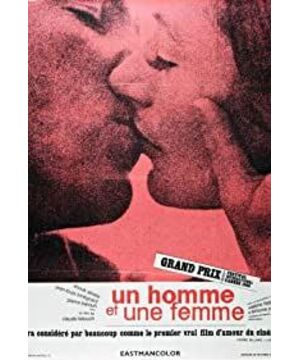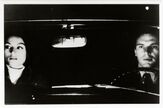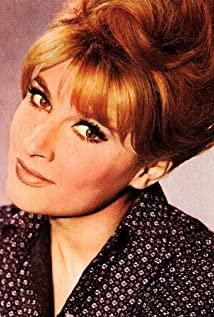This film tells a very ordinary love story: a widower meets a widow and falls in love. Although a woman does not forget her ex-husband's old feelings, she cannot withstand the persistent pursuit of this man. This is the most natural thing in the world. There are endless stories of this kind, and there are too many movies made, but it is really not an easy task to really make a good movie that is unconventional.
This kind of ordinary stories that may happen every day, because they are the closest to life, are most likely to arouse the audience's sympathy and recognition. "A Man and a Woman" is director Claude Le Rouch's famous work and his representative work. Almost all of his films describe the daily lives of such ordinary people. The middle class, which constitutes the main class of Western society, is the protagonist of his films. These people’s dreams are beach vacations, romantic feelings, high-paying jobs in large modern companies, and they should dress elegantly although they are not high-end fashion. They should go to theaters and theaters or go to coffee bars to relax. To sit, at least three or five confidants must gather at a friend's house, drink an aperitif, and make a high-level commentary that is irrelevant. These scenes can be seen everywhere in the films of Le Rouch. His lens is always aimed at country houses, luxury racing cars, red men and green women under sun umbrellas on the beach, and the pair of swinging wipers on the front windows of cars traveling in the rain on the highway. Such less ambitious subjects reflect the ideal life of Bourgeois and make them fascinated. The ending of the film is always that the protagonists get what they want, and they get what they want. Everyone is happy, and every audience will walk out of the theater contentedly.
When someone asked the reason for the film’s success, Le Rouch said: “To make this kind of very ordinary story beloved by the audience, the first thing is to be sincere, and to make the audience feel that they are also in line with certain plots of the film. Or the things depicted have a direct connection, which makes them feel that they have experienced personally, and then they may have a strong resonance effect. Because the protagonist’s experience is real (taken from), what they say is from the bottom of their hearts (performance) ), as long as they are photographed from the most usual angle and without skill (photography), they can be recognized by the audience. Second, the details must be true and believable, but also lively and intriguing. A film may be because One or two falsified or neglected details lead to failure. The impatient audience will yell "Hu Bian" and leave their seats immediately. The director will also be notorious because of this. I think if a film is neither sincere nor credible, Don’t waste money and squander the audience’s time, because the audience would rather go to see such amazing superman or aliens than come to the theater to be fooled."
This film really makes people feel sincere. Le Rouch believes that the composition of the film and the performance of the actors must be based on "instinctive spontaneity", and must not be based on the already designed shooting angle, allowing actors to perform and recite script lines in accordance with prescribed actions. Because every actor has his own personality and characteristics that are different from others, how can it be possible for different actors to do the same action and speak the same words in the same tone to express his feelings? A movie made according to this traditional program should not be called a movie. Leros said that the studio is the creative world of painters, and the study is the creative world of writers, where their thoughts and inspirations can freely gallop, while the creative world of directors can only be on the shooting scene: only facing actors who show their true feelings. , The director can record his inspiration and feelings in the camera with the best expression method according to the spirit of the storyline.
This famous director, who was not from a film academy, never writes a screenplay. He thinks that doing so will only restrict his hands and feet, restrict his creative inspiration, hinder his live performance, and lead to unreal films. His shooting principle is always "follow my own feelings". He always gives the fullest confidence to the actors, as long as they correctly grasp the psychology of the characters, he never points to their performances, but allows them to give full play. Le Rouch, who is a producer and photographer, always carries a portable camera on his own, directing the lighting, recording, and makeup artists who are inseparable from the left and right, and co-creates with the actors on the set. He said: "The director's camera is the same as the paintbrush in the hands of a painter. If Van Gogh hands the paintbrush to his friends, even if the subject matter, color and light are all determined by him, even the length and thickness of each stroke will be completely obeyed by him. According to the intent, the signature of this work should not be Van Gogh anymore."
Although the critics have different opinions on Le Rouch's film, everyone agrees that he is the most typical representative of "camera-pen" and "author's film". When ordinary playwrights create movie scripts, the first thing they think of is the plot, but when Leroche writes the script and dialogue, the first thing he thinks of is the picture. He designed the plot according to the scenes he thought was the most suitable for the plot, and then took them into the shot according to the atmosphere of the shooting venue and the inspiration that the actor's performance brought him. There are only a handful of members of his film crew, and he is completely at the mercy of the director and producer. He is the unique owner of the work. During the "New Wave" period, when he founded the film creation method and critical principles of "author theory", Truffau said: "The starting point of author theory is that a director with a certain idea, the film he produces must be completely derived from him. His own ideas, the finished work must be exactly the same as what he had conceived. In other words, the film and the director must be inseparable as a single person or'shadow as a person.'" Using this principle to measure Le Rouch, he is completely qualified. In terms of ideas, LeRouch once said: “Hemingway believes that there are only three things in the world that are worth writing about. These are: love, murder, and war. And I think that only love is worth a shot, because we I always live surrounded by evil forces such as murder, war, death, cruelty and violence. I don’t want the audience to see these odious things on the screen.” This idea of expressing beautiful love runs through Le Rouch. Series of films, such as "Love with Hypothesis" (1962), "A Girl and a Gun" (1964), "A Great Moment" (1965), "A Man and a Woman" (1966), "Living for Life" "(1967), "Thirteen Days in France" (1968), "Life, Love, Death" (1968), "A Man Who Pleases Me" (1969), "Aventure is Aventure" (1972), " Good Years" (1973), "A Whole Life" (1974), "Marriage" (1974), "Another Man, Another Chance" (1977), "Only the Two of Us" (1979), "Some People and Others" People" (1981), "Eddie and Marcel" (1983), "Long Live Life" (1984), "A Man and a Woman Twenty Years Later" (1986), etc. These films have all reached the director's " The purpose of making the audience spend some warm time.
Leros believes that many films appear to be insincere because "the car was braked when it was time to accelerate." When the story reaches its climax, the rush must be accelerated, and it must be done in one go, and it must not stop abruptly. When Jean-Louis received the telegram from Anna "I love you", if he described the celebration too much or asked him to return to Paris the next day, it would be tantamount to "braking". He must be allowed to set off in the starry night without stopping. He didn't see Anna rushing into the air in Paris and could not rest before continuing to fly to Deauville. Only in this way can Jean-Louis' sincere and eager feelings be expressed, and Anna can be moved with this sincerity. When there were unexpected twists and turns in the hotel because Anna did not forget his old feelings, he asked Jean-Louis to run faster than the train, and first Anna went to the Paris train station. Even the hard-hearted people would be moved by it. At this time, Anna Can't help but throw himself into his arms, and he is naturally sincere and credible.
Details that are both unexpected and reasonable will leave a deep impression on the audience. At the beginning of the film, only a close-up shot of Jean-Louis boarding a car was taken. He inconsistently gave instructions to the driver. The audience would think that this person had a problem with his head. At this time, we could not see the driver's reaction. When the car started swaying from side to side, it was in danger of an accident. After zooming, the lens was pulled to let the audience see that it turned out to be a five or six-year-old child sitting in the driver's seat. It suddenly dawned on people that they both found it interesting and felt that the father and son were extraordinary.
View more about A Man and a Woman reviews










